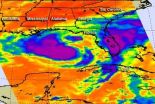(Press-News.org) After waking up, the concentration of the stress hormone cortisol in saliva rises considerably; this is true not only for grown-ups but for babies as well. A research team from the Ruhr-Universität Bochum and from Basel has reported this finding in the journal Psychoneuroendocrinology. "This gives us a new, non-invasive and uncomplicated possibility to already research the activity of the stress system during infancy," Prof. Dr. Gunther Meinlschmidt, of the Clinic of Psychosomatic Medicine and Psychotherapy at the LWL University Hospital of the RUB, said. The information not only open doors to the pursuit of as-yet unresolved research inquiries, but could also be used in the future to diagnose illnesses in the hormone-producing organs, such as the adrenal gland, of infants.
Testing stress hormones: easy with grown-ups, hard with babies
Scientists usually test the stress hormones of grown-ups by placing test subjects in an experiment under stress-inducing conditions. Since a similar practice is, for ethical reasons, unthinkable to use with babies, it is rather more difficult to find out how well-developed their stress systems are. The German-Swiss research team circumvented this problem by observing a naturally occurring "stress situation" – waking up. The cortisol-concentration in grown-ups rises after they wake up, presumably to prepare the body for the requirements of the day. At what age this cortisol-reaction develops has long been unclear.
Cortisol levels rise in babies upon waking up
Data from 64 newborns and infants between the ages of three weeks and six months were used in the study. On two days the infants' parents had their children suck on a small cotton swab at home, once right after waking up and once half an hour later. Through this saliva, the scientists determined the cortisol-concentration. The cortisol amount rose considerably after the infants awoke in 63 % of cases. Neither the hour that the child woke up nor breastfeeding after waking played any role in these findings.
The shorter the pregnancy, the less the cortisol-level rises
Instead the length of the pregnancy had an effect. The earlier the children were born, the less their cortisol-levels rose after they woke up. "The stress hormone system may be less mature in babies who were born after a shorter pregnancy, which could have negative consequences," assistant professor Marion Tegethoff, of the Faculty for Psychology at the University of Basel, said. Since cortisol can inhibit the immune system, the lack of cortisol-level rises could lead to excess immunological responses, similarly to what occurs with allergies.
Approaching new research questions through saliva tests
Stress increases the risk for mental disorders and bodily illnesses. There is now a new method available to investigate the stress systems easily in babies. Prof. Meinlschmidt, head of the Research Department of Psychobiology, Psychosomatics, and Psychotherapy at the LWL University Hospital in Bochum explains future research questions: "In some rodents the hormonal stress response in the first weeks of life is, for a specific timeframe, close to shut down – perhaps to protect organs that are developing during this time. It is still unknown if there is a comparable phase in humans, since it has long been impossible, because of ethical reasons, to repeatedly assess the hormonal stress reaction."
###
Bibliographic record
M. Tegethoff, N. Knierzinger, A.H. Meyer, G. Meinlschmidt (2012): Cortisol awakening response in infants during the first six postnatal months and its relation to birth outcome, Psychoneuroendocrinology, doi: 10.1016/j.psyneuen.2012.08.002
Further information
Prof. Dr. Gunther Meinlschmidt; Research Department of Psychobiology, Psychosomatics, and Psychotherapy; Clinic of Psychosomatic Medicine and Psychotherapy, LWL University Hospital, Alexandrinenstrasse 1-3, 44791 Bochum, Germany, Phone: +49/234/5077-3173
gunther.meinlschmidt@rub.de
Click for more
Research Department of Neuroscience at RUB
http://www.rd.ruhr-uni-bochum.de/neuro/index.html.en
Editor: Dr. Julia Weiler
New method: Research team analyzes stress biology in babies
Pregnancy duration predicts stress response in the first months of life
2012-08-28
ELSE PRESS RELEASES FROM THIS DATE:
Ten year decline in ischemic stroke after AMI
2012-08-28
Munich, Germany – August 28 2012: The risk of ischemic stroke one year after acute myocardial infarction (AMI) dropped by 21% over a ten year period, according to research presented at ESC Congress 2012. The analysis of data from two Swedish registries was presented by Dr Anders Ulvenstam, and suggests that the reduction is due to improvements in AMI care.
Ischemic stroke is a well known, relatively rare but potentially devastating complication following myocardial infarction. It can lead to severe neurological handicap and death for the patient and it is associated with ...
Global platelet reactivity identifies high risk ACS patients
2012-08-28
Munich, Germany – August 26 2012: Global platelet reactivity is more effective than responsiveness to clopidogrel in identifying acute coronary syndrome (ACS) patients at high risk of ischemic events, according to research presented at the ESC Congress today. The results from the RECLOSE 2-ACS study were presented by Dr Rossella Marcucci from Italy.
The Responsiveness to Clopidogrel and Stent thrombosis 2 – ACS (RECLOSE 2-ACS) study is a prospective, observational, referral center cohort study of 1,789 patients with acute coronary syndromes undergoing percutaneous coronary ...
The raccoon spreads dangerous diseases as it invades Europe
2012-08-28
Furry, agile, intelligent and voracious: the raccoon is far from being a cuddly toy, which is what many people believe when they get one as a pet. It is more like an invader that escapes and is able to adapt and survive in new habitats. According to a study, its expansion across Spain and Europe is bringing infectious and parasitic diseases like rabies. This puts the health of native species and people at risk.
Originating in North America, the raccoon (Procyon lotor) is an invasive species that has established itself in Europe due to hunting and the fur trade along with ...
How 'beige' fat makes the pounds melt away
2012-08-28
The numbers of obese people are climbing steeply all over the world – with obvious major consequences for their health. Due to excess food intake and a lack of physical activity, but also due to genetic factors, the risk for overweight people dying from diseases like coronary heart disease, diabetes und atherosclerosis increases. "The body's fat reserves are actually used as a place to store energy that allows surviving lean times," says Prof. Dr. Alexander Pfeifer, Director of the Institute of Pharmacology and Toxicology of the University of Bonn. "But nowadays, hardly ...
Capturing movements of actors and athletes in real time with conventional video cameras
2012-08-28
This press release is available in German.In the computer graphics (CG) animated comedy "Ted," which is running now in the cinemas, Ted is a teddy bear who came to life as the result of a childhood wish of John Bennett (Mark Wahlberg) and has refused to leave his side ever since. CG Animated characters like "Ted" have become a standard of Hollywood's movie productions since the blockbuster "Avatar" with its blue-skinned computer-animated characters won three Oscars and brought in three billion US dollars, digital animated characters have become a standard of Hollywood's ...
ESC Acute Cardiovascular Care Association launched
2012-08-28
ACCA was previously the ESC Working Group on Acute Cardiac Care. Today it becomes one of six ESC Associations, whose presidents are invited to ESC Board meetings. "It will be easier to inform the ESC Board about the activities of the association," said Professor Christiaan Vrints (Belgium), outgoing chairman of the Working Group on Acute Cardiac Care. "We will also have a bigger impact on the policies and the development of the ESC as an organisation."
The Working Group on Acute Cardiac Care had the largest and fastest growing membership of ESC working groups. Over the ...
Study of tribe could help find East Asian skin color genes
2012-08-28
Genetic investigation of a Malaysian tribe may tell scientists why East Asians have light skin but lower skin cancer rates than Europeans, according to a team of international researchers. Understanding the differences could lead to a better way to protect people from skin cancer.
While the genetics of skin color is largely unknown, past research using zebrafish by Penn State College of Medicine's Keith Cheng, M.D., Ph.D., identified the gene in Europeans that differs from West Africans and contributes to a lighter skin color. Mutations in the genes SLC24A5 and SLC45A2 ...
Trudeau researchers identify unforeseen regulation of the anti-bacterial immune response
2012-08-28
Saranac Lake, N.Y. – August 28, 2012 — New research from the laboratory of Dr. Andrea Cooper at the Trudeau Institute, just published in the European Journal of Immunology, holds promise for the improved prevention and treatment of bacterial infections and the life-threatening complications of chronic inflammation that can result from them. The publication title is "Nitric oxide inhibits the accumulation of CD4+CD44hiTbet+CD69lo T cells in mycobacterial infection".
Following a typical bacterial infection, the immune response is manifested by the accumulation of immune ...
NASA watching Issac's approach to US Gulf Coast
2012-08-28
VIDEO:
An animation of satellite observations from August 26-28, 2012 shows Tropical Storm Isaac moving past the Florida Keys and into the Gulf of Mexico, nearing landfall in the U.S. Gulf...
Click here for more information.
NASA satellites have been providing valuable data to forecasters at the National Hurricane Center watching the development and progression of powerful Tropical Storm Isaac as it heads for landfall.
The Moderate Resolution Imaging Spectroradiometer ...
By detecting smallest virus, researchers open possibilities for early disease detection
2012-08-28
NEW YORK, August 28, 2012 – Researchers at Polytechnic Institute of New York University (NYU-Poly) have created an ultra-sensitive biosensor capable of identifying the smallest single virus particles in solution, an advance that may revolutionize early disease detection in a point-of-care setting and shrink test result wait times from weeks to minutes.
Stephen Arnold, university professor of applied physics and member of the Othmer-Jacobs Department of Chemical and Biomolecular Engineering, and researchers of NYU-Poly's MicroParticle PhotoPhysics Laboratory for BioPhotonics ...
LAST 30 PRESS RELEASES:
An ECOG-ACRIN imaging study solves a long-standing gap in metastatic breast cancer research and care: accurately measuring treatment response in patients with bone metastases
Cleveland Clinic presents final results of phase 1 clinical trial of preventive breast cancer vaccine study
Nationally renowned anesthesiology physician-scientist and clinical operations leader David Mintz, MD, PhD, named Chair of the Department of Anesthesiology at the UM School of Medicine
Clean water access improves child health in Mozambique, study shows
Study implicates enzyme in neurodegenerative conditions
Tufts professor named Fellow of the National Academy of Inventors
Tiny new device could enable giant future quantum computers
Tracing a path through photosynthesis to food security
First patient in Arizona treated with new immune-cell therapy at HonorHealth Research Institute
Studies investigate how AI can aid clinicians in analyzing medical images
Researchers pitch strategies to identify potential fraudulent participants in online qualitative research
Sweeping study shows similar genetic factors underlie multiple psychiatric disorders
How extreme weather events affect agricultural trade between US states
Smallholder farms maintain strong pollinator diversity – even when far from forests
Price of a bot army revealed across hundreds of online platforms worldwide – from TikTok to Amazon
Warblers borrow color-related genes from evolutionary neighbors, study finds
Heat signaling from plants is an ancient pollinator signal
New index reveals the economics underlying the online manipulation economy
High-resolution satellite observations reveal facility-level methane emissions worldwide
Researchers discover how Ebola and Marburg disrupt the gastrointestinal tract
Feeling the heat
Eastward earthquake rupture progression along the Main Marmara Fault towards Istanbul
Scientists uncover how Earth’s mantle locked away vast water in early magma ocean
Scientists uncover key driver of treatment-resistant cancer
Rare image of Tatooine-like planet is closest to its twin stars yet
Music: Popular song lyrics have become more negative since 1973
Marine ecology: Killer whales tail dolphins to hunt salmon
ADHD prescriptions on the rise, study finds
How to build a genome
Sharp rise in ADHD stimulant prescriptions in Ontario, research finds
[Press-News.org] New method: Research team analyzes stress biology in babiesPregnancy duration predicts stress response in the first months of life




